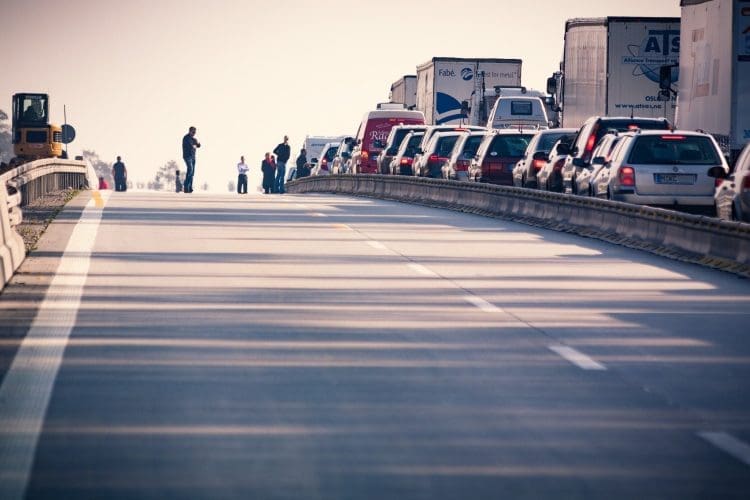Bicycle riding is an enjoyable and healthy way to stay active and get around, but it can also be dangerous if proper safety measures are not taken.
Understanding the common causes of bicycle accidents and taking steps to protect yourself on the road is crucial to ensuring your safety as a cyclist. In recent years, the number of bicycle accidents has increased, and many of these accidents could have been prevented if proper safety precautions had been taken. In the text below, we’ll explore some of the most common causes of bicycle accidents, including distracted driving, failure to yield, and riding in dangerous conditions.
We’ll also discuss strategies for protecting yourself on the road, such as wearing protective gear, staying visible to motorists, obeying traffic laws, and staying alert and aware of your surroundings. Read on, as by understanding the risks and taking proactive steps to protect yourself on the road, you can enjoy the many benefits of cycling while staying safe and avoiding accidents.
Stay focused on the road
Distracted driving, failure to yield right-of-way, improper lane changes, and speeding are among the most frequent causes of bicycle accidents involving motor vehicles. Additionally, riding in poor visibility conditions or on roads with heavy traffic can increase the risk of accidents. It’s never easy, but we strongly advise you to take a pause whenever you feel sleepy, lay off any electrical devices that might mitigate your focus and concentration, and even play something on the radio that will keep your mind occupied instead of wandering off with your thoughts.
Protective gear, anyone?
Wearing a helmet and other protective gear is essential for any cyclist. In the event of an accident, a helmet can significantly reduce the risk of a head injury and other serious injuries. Other protective gear, such as knee pads, elbow pads, and gloves, can also help protect cyclists from scrapes, bruises, and other minor injuries. It’s important to choose a helmet that fits properly and meets safety standards and to wear it every time you ride your bike, no matter how short the distance.
Others should be able to see you too!
Staying visible to motorists is an important aspect of bicycle safety. This can be achieved by wearing brightly colored or reflective clothing, using lights on your bike, and avoiding riding in blind spots. When cycling on the road, it’s important to make yourself visible to drivers from all angles. Using a bright front light and rear red light can help ensure you are seen in low-light conditions. Wearing reflective clothing can also help you stand out to drivers during the day or night.
An experienced bike wreck lawyer can tell you how lots of cases get lost due to this factor, even though the accident came to be due to the driver’s negligence.
Obey the law
Obeying all traffic laws is a critical component of bicycle safety. Cyclists should always follow the same rules of the road as motorists, including stopping at stop signs and red lights and using hand signals when turning or changing lanes. This not only helps keep cyclists safe but also helps them earn the respect of motorists who share the road with them. Additionally, obeying traffic laws can help improve overall road safety for all users, including pedestrians, motorists, and other cyclists.
Also, sometimes due to negligence, you could have potential issues with authorities or even become involved in an accident because someone else didn’t obey the rules and laws as you did. In this case, you’ll need an accident lawyer to navigate the complex legal system and secure compensation for your injuries. Accident lawyers can help clients obtain financial compensation for medical expenses, lost wages, and other damages resulting from an accident, providing them with the support they need to move forward after a difficult time.
You don’t have to be on your toes, but concentrate
Staying alert and aware of your surroundings at all times is crucial for bicycle safety. Cyclists should avoid using headphones or other devices that could distract them from the road. Instead, they should remain focused on the road ahead and keep an eye out for potential hazards such as potholes, debris, or sudden changes in traffic. You’ll be able to anticipate and respond to potential dangers more quickly, avoiding accidents. It’s also important to be aware of other road users, including pedestrians, other cyclists, and motorists, and to adjust your speed and behavior accordingly.
Look at the weather forecast
It’s important for cyclists to avoid riding in bad weather or poor visibility conditions whenever possible. Rain, snow, and fog can impair visibility and make roads slippery, increasing the risk of accidents. Cyclists should also avoid riding at night or in low-light conditions without proper lighting, reflectors, or other visibility aids. If it’s necessary to ride in these conditions, cyclists should take extra precautions, such as wearing bright or reflective clothing, using front and rear lights, and riding at a slower speed.
Simply following this rule will help you avoid bad weather and poor visibility conditions, drastically reduce the risk of accidents, and stay safe on the road.
Pay attention to all the “angles” of the road
As a cyclist, you should be extra cautious when riding on roads with heavy traffic or narrow lanes. In these situations, it’s important to ride defensively and anticipate potential hazards. Try to stay as far to the right of the road as possible but also avoid riding too close to the curb, where debris or other hazards may be present. If the road is too narrow for a cyclist and a car to safely share, cyclists may need to take the full lane to ensure their safety. It’s also important to use hand signals and make eye contact with drivers to ensure they are aware of your presence. By being extra cautious and aware of potential dangers, you can navigate heavy traffic or narrow lanes safely and confidently.
Have the following in mind: signaling your intentions while riding a bicycle is crucial for your safety on the road. By using hand signals to indicate when you’re turning or changing lanes, you can communicate your movements to drivers, pedestrians, and other cyclists. This allows them to anticipate your actions and adjust their own accordingly, reducing the risk of accidents.
Hand signals are easy to learn and can be used by anyone, regardless of their level of experience. To signal a left turn, extend your left arm straight out to the side. To signal a right turn, extend your left arm and bend it up at the elbow, with your hand pointing upwards. To signal a stop, extend your left arm down at the elbow with your hand pointing downward.
Always assume that drivers do not see you and ride defensively
Even if a cyclist is using proper lighting, wearing reflective clothing, and following all traffic laws, there’s always a risk of being overlooked by a distracted or inattentive driver. Therefore, it’s crucial to ride defensively, meaning anticipating potential hazards and taking action to avoid them. This might mean slowing down, changing lanes, or even stopping if necessary. Cyclists should also make eye contact with drivers and use hand signals to indicate their intentions. Assuming that drivers do not see you and riding defensively, you can help reduce the risk of accidents and stay safe on the road.
You’re the one holding the wheel
Staying in control of your bike at all times is a critical aspect of bicycle safety. This means riding at a safe and appropriate speed, maintaining a proper distance from other road users, and avoiding sudden or jerky movements that could cause a loss of balance or control. Cyclists should also ensure that their bike is properly maintained, with brakes, tires, and other components in good working order. It’s important to be aware of road conditions, such as potholes or wet surfaces, and adjust your speed and behavior accordingly.
Stay in your line
It’s important for cyclists to avoid riding on sidewalks or other areas where bicycling is prohibited. While it may seem like a safer option, riding on sidewalks can actually be more dangerous than riding on the road. Pedestrians may not expect cyclists on the sidewalk and may not be aware of their presence, leading to collisions or other accidents. In addition, riding on sidewalks can be illegal in some areas, leading to potential fines or other penalties. It’s important to know and follow local laws and regulations regarding bicycling and to choose safe and appropriate routes for riding.
Make sure everything is in check
Keeping your bike in good condition by performing regular maintenance checks and keeping your tires properly inflated is an important aspect of bicycle safety. Regular maintenance checks can help identify and fix potential issues before they become a safety hazard, such as loose or worn components. Keeping your tires properly inflated can help improve control and stability while riding, as well as reduce the risk of flats. Cyclists should also ensure that their brakes, gears, and other components are functioning properly before each ride. By maintaining their bike in good condition, you can help ensure a safe and enjoyable ride.
If you don’t see, you can’t ride as intended
Avoiding riding at night or in low-light conditions without proper lighting, reflectors, or other visibility aids is crucial for bicycle safety. Cyclists should use front and rear lights, as well as reflective clothing and accessories, to increase their visibility to other road users. In addition, cyclists should be aware of their surroundings and adjust their behavior accordingly, such as reducing their speed and avoiding areas with poor visibility. It’s important to follow local laws and regulations regarding bicycle lighting and visibility and to make sure that all lights and reflectors are functioning properly before each ride.
Also, it’s important to be extra cautious when riding a bike at night or in low-light conditions. Visibility can be greatly reduced, making it harder for drivers to see you on the road. If possible, avoid riding at night altogether. If you must ride at night, make sure your bike is equipped with front and rear lights and reflective gear to increase your visibility. Avoid wearing dark clothing and stay in well-lit areas as much as possible. Always ride defensively and be aware of your surroundings, especially when approaching intersections or turning.
Never abuse any substances
Riding a bike while impaired can significantly impair your judgment and reaction time, making it much more challenging to navigate obstacles, avoid hazards, and respond to unexpected situations. Even a small amount of alcohol or drugs can affect your balance, coordination, and ability to operate a bike safely. It’s important to avoid riding a bike after consuming drugs or alcohol and to make alternative arrangements for transportation, such as taking a taxi, ride-sharing service, or public transit.
You can always learn more
Taking a bike safety course or seeking advice from experienced cyclists is an excellent way to improve your riding skills and knowledge. These courses can teach you about bike handling techniques, traffic laws, and other critical aspects of bicycle safety. They can also provide you with the opportunity to practice your skills in a controlled and safe environment, such as a bike path or parking lot. Seeking advice from experienced cyclists can also be helpful, as they can share their knowledge and experience to help you become a more confident and skilled rider.
Stay informed
Staying informed about local laws and regulations that affect bicycle safety and advocating for safer roads and infrastructure in your community are important aspects of promoting bicycle safety. It’s important to know your rights as a cyclist and to be aware of any new or proposed laws that could impact your safety. You can also work with local advocacy groups and government officials to push for safer roads and bike infrastructure, such as protected bike lanes, bike racks, and other amenities that can make cycling safer and more accessible.
In short, understanding the common causes of bicycle accidents is crucial for protecting yourself on the road. By being aware of the risks, you can take steps to minimize them and ensure your safety while cycling. Always remember to wear appropriate safety gear, follow traffic laws, and remain alert and aware of your surroundings. By taking these precautions and staying informed, you can enjoy the many benefits of cycling while minimizing the risks of accidents and injuries. So stay safe and have fun cycling!
No products found.


















